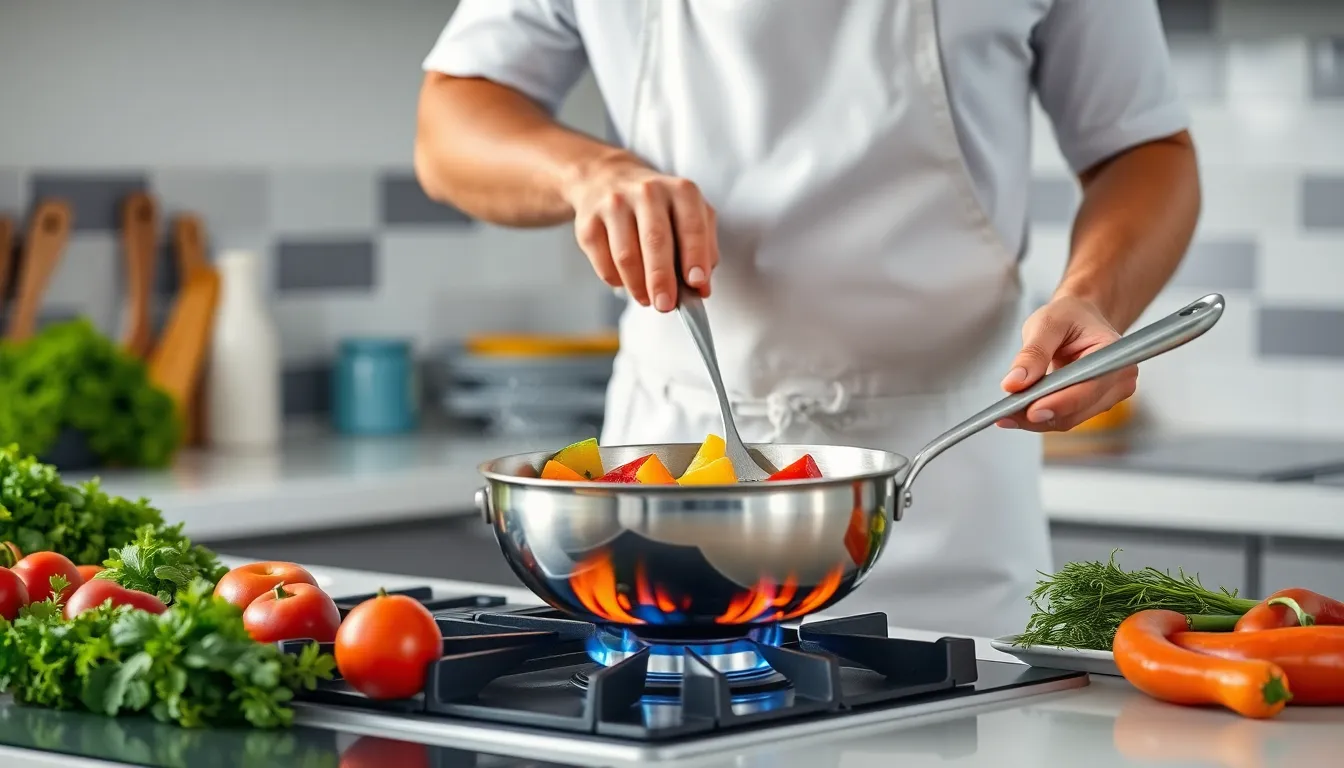In a world where food is more than just sustenance, culinary artisans stand at the forefront of a delicious revolution. These skilled individuals blend creativity and tradition, transforming simple ingredients into extraordinary dishes that tantalize the senses. With a deep-rooted passion for their craft, they elevate dining experiences, turning meals into memorable events.
Culinary artisans aren’t just chefs; they’re innovators who embrace local flavors and seasonal produce, crafting unique recipes that reflect their cultural heritage. As the farm-to-table movement gains momentum, these artisans play a pivotal role in connecting consumers with the source of their food. Their dedication to quality and artistry not only enhances the culinary landscape but also fosters a greater appreciation for the art of cooking.
Table of Contents
ToggleOverview of Culinary Artisans
Culinary artisans possess specialized skills that elevate food preparation to an artistic level. These individuals focus on high-quality ingredients, often sourcing them from local farms and markets. They emphasize the use of seasonal products, ensuring freshness and sustainability in their creations.
Culinary artisans apply traditional techniques and innovative methods to craft their dishes. They merge flavors and textures, creating unique dining experiences that reflect culinary heritage. Examples include artisanal bakers who produce handcrafted breads and pastry chefs who master intricate dessert techniques.
Culinary artisans contribute significantly to the farm-to-table movement, connecting consumers directly with food origins. They educate diners about the ingredients, fostering an appreciation for the culinary process. Through their work, these artisans promote cultural traditions while supporting local economies.
Recognized for their creativity, culinary artisans often participate in community events and culinary festivals. They showcase their skills through demonstrations, allowing individuals to experience the artistry of food firsthand.
Skills and Techniques

Culinary artisans employ a blend of traditional cooking methods and modern culinary innovations to craft exceptional dishes. These skills not only showcase their talent but also reflect the rich tapestry of culinary heritage.
Traditional Cooking Methods
Culinary artisans excel in various traditional cooking methods that emphasize authenticity and depth of flavor. These techniques include:
- Sautéing: Heats ingredients quickly in a small amount of fat, preserving textures and flavors.
- Braising: Combines slow cooking with moisture, enhancing the tenderness of meats and vegetables.
- Roasting: Brings out natural sweetness in ingredients through dry heat, resulting in caramelization.
- Fermentation: Preserves ingredients while developing complex flavors, common in breads and pickled items.
- Sous-vide: Involves vacuum-sealing food and cooking it at precise temperatures, ensuring consistency and flavor retention.
These methods form the backbone of culinary practices and contribute significantly to the quality of dishes prepared by artisans.
Modern Culinary Innovations
Culinary artisans embrace modern innovations that elevate culinary experiences. Techniques such as:
- Molecular Gastronomy: Utilizes scientific principles to manipulate ingredients, creating unique textures and presentations.
- Fusion Cuisine: Combines flavors and cooking techniques from different cultures, resulting in innovative dishes.
- Plant-Based Cooking: Focuses on vegetables and legumes, highlighting sustainability while offering creative alternatives.
- Food Photography and Plating: Enhances visual appeal, transforming dishes into works of art to engage diners before they taste.
- Vertical Farming: Integrates agriculture with urban living, providing fresh, local ingredients while minimizing environmental impact.
These innovations expand the boundaries of what culinary artisans can create, appealing to a diverse audience and pushing the art of cooking into new realms.
Profiles of Notable Culinary Artisans
Culinary artisans around the globe have made significant impacts on their communities and beyond, using their skills to foster a deeper appreciation for food. This section highlights both local legends and global influencers who excel in the culinary arts.
Local Legends
Local culinary artisans exemplify a strong connection to their communities. They often focus on regional cuisines, showcasing seasonal ingredients and traditional techniques. Notable figures include:
- Alice Waters: Known for her role in the farm-to-table movement, she emphasizes organic and locally sourced ingredients at her restaurant, Chez Panisse, in Berkeley, California.
- Daniel Boulud: Celebrated for his innovative French cuisine, he integrates local flavors into global dishes across his various restaurants in New York City.
- José Andrés: Esteemed for his humanitarian efforts and dedication to Spanish cuisine, he promotes local produce through his acclaimed restaurants and culinary schools.
These artisans not only craft exceptional dishes but also inspire others to appreciate local food culture.
Global Influencers
Global culinary influencers bring diverse perspectives and techniques to the world of cooking. Their expertise transcends borders and encourages culinary exploration. Some prominent names include:
- Massimo Bottura: Renowned for his modern take on Italian cuisine, he operates Osteria Francescana in Modena, Italy, and advocates for food waste reduction through his non-profit, Food for Soul.
- René Redzepi: The chef behind Noma in Copenhagen, he emphasizes foraging and Nordic ingredients, pushing the boundaries of traditional Nordic cuisine.
- Dominique Crenn: With her Michelin-starred restaurant Atelier Crenn in San Francisco, she champions storytelling through food, focusing on sustainable practices and artistic presentation.
These global figures contribute to the evolution of culinary arts by blending unique cultural influences with innovative techniques, thereby enriching the global gastronomic experience.
The Role of Culinary Artisans in Food Culture
Culinary artisans significantly influence food culture by merging artistry and tradition in their creations. They shape the dining experience through meticulous presentation and flavor profiles, ensuring every dish tells a story. Local flavors and seasonal ingredients become hallmarks of their work, reflecting the cultural intricacies of the region.
Culinary artisans prioritize high-quality, locally sourced ingredients from farms and markets. This commitment not only elevates flavor but also fosters connections between consumers and the sources of their food. Such transparency encourages sustainability within the community and strengthens local economies.
Culinary artisans engage diners through education, sharing knowledge about various ingredients and their culinary origins. Their participation in the farm-to-table movement emphasizes the importance of understanding and appreciating the food’s journey from production to the plate. By doing so, they cultivate a strong awareness of culinary heritage and inspire a newfound interest in traditional practices.
Community events and culinary festivals serve as platforms for culinary artisans to share their skills. Demonstrations offer attendees a firsthand look at the artistry involved in preparation, deepening the appreciation for culinary craft. These artisans champion cultural traditions through their dedicated practice, enhancing gastronomy’s richness while simultaneously pushing boundaries and exploring new techniques.
The blend of traditional practices and modern innovations further manifests through culinary artisans’ work. Techniques like fermentation and sous-vide honor historical methods, while approaches such as molecular gastronomy and plant-based cooking introduce contemporary elements. This fusion bridges the gap between heritage and modernity, appealing to a broad audience and ensuring the culinary arts evolve continuously.
Challenges Faced by Culinary Artisans
Culinary artisans encounter various challenges that impact their creativity and the quality of their work.
- Sourcing Ingredients: Artisan chefs rely on high-quality, local ingredients. Fluctuations in availability or prices can hinder their ability to maintain consistent menus.
- Competition: Increased competition from other culinary artisans and restaurants presents a significant challenge. Standing out in a saturated market requires constant innovation and exceptional service.
- Labor Shortages: Skilled labor shortages affect the culinary industry. Finding trained personnel who align with their vision and standards becomes increasingly difficult for many artisans.
- Economic Factors: Economic downturns can reduce consumer spending on dining experiences. Culinary artisans may struggle to sustain their businesses during challenging economic periods.
- Adapting to Trends: Trends in cuisine change rapidly, and artisans must adapt their practices to meet evolving consumer preferences. Staying ahead of trends while preserving their culinary identity poses a continuous challenge.
- Food Safety Regulations: Compliance with stringent food safety and health regulations demands time and resources. Ensuring all practices meet these requirements can be burdensome and requires ongoing education.
- Work-Life Balance: Long hours and high-pressure environments often lead to burnout. Culinary artisans frequently find it challenging to balance their work commitment with personal lives.
These challenges influence the creative processes of culinary artisans, requiring them to develop resilience, adaptability, and strategic thinking to thrive in the evolving culinary landscape.
Culinary artisans play a vital role in shaping the food landscape through their dedication and creativity. Their ability to blend tradition with innovation not only enhances the dining experience but also fosters a deeper connection between consumers and their food. By prioritizing local ingredients and sustainable practices, they contribute to vibrant communities and promote cultural heritage.
Despite facing numerous challenges, culinary artisans continue to inspire with their passion and resilience. Their commitment to excellence drives the evolution of culinary arts, ensuring that each dish is a celebration of flavor and artistry. As they navigate the complexities of the culinary world, these artisans remain steadfast in their mission to elevate food into a true form of art.






